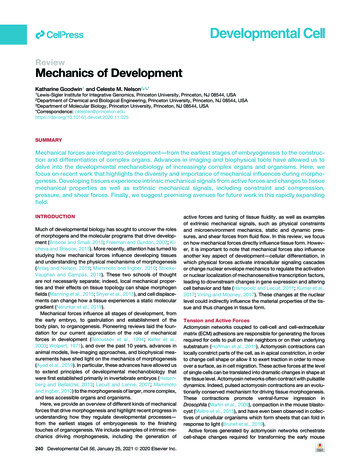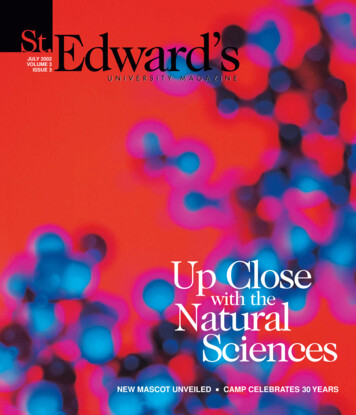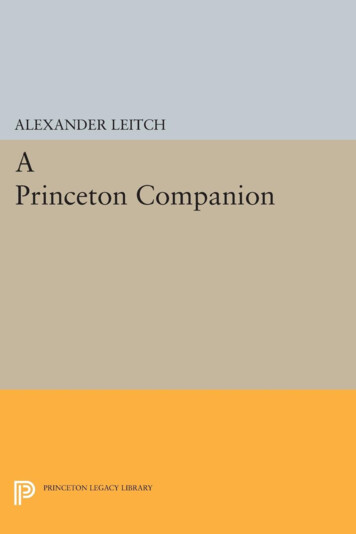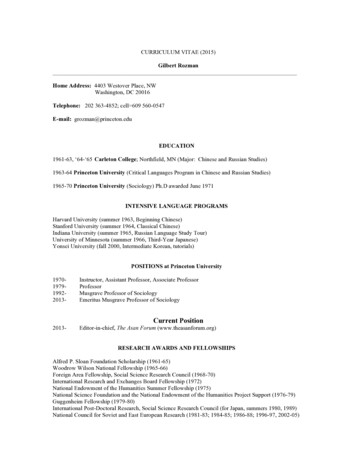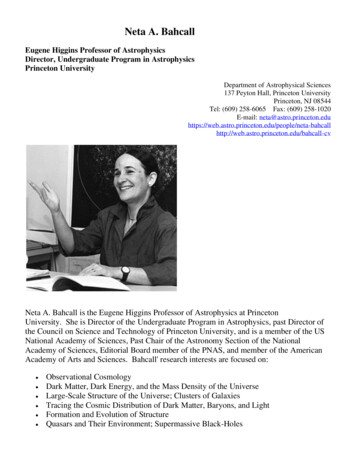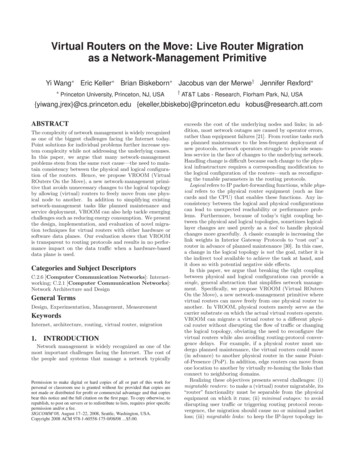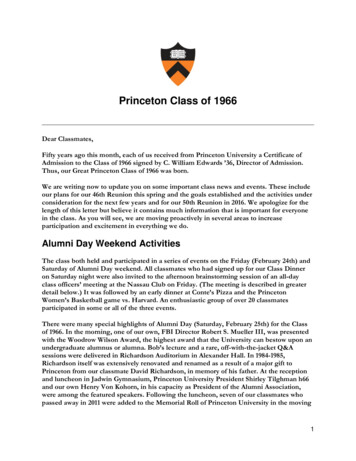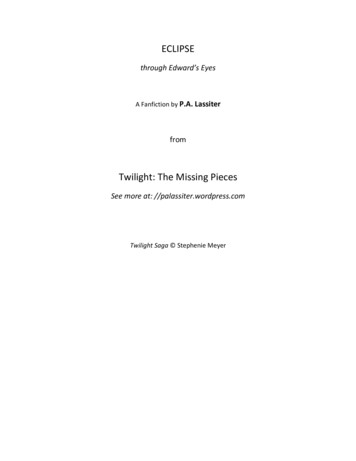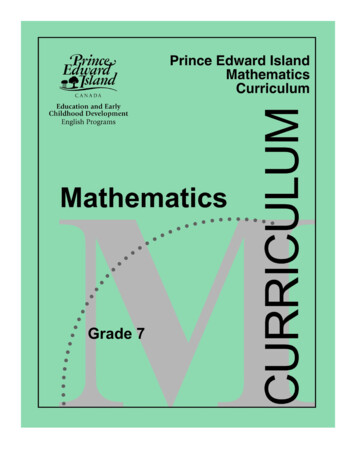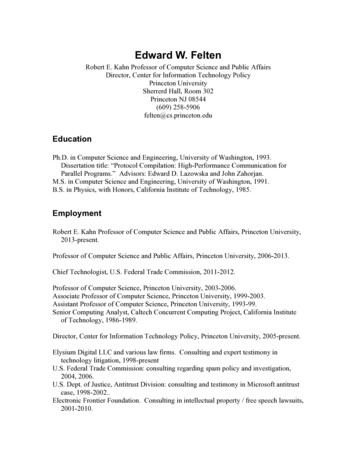
Transcription
Edward W. FeltenRobert E. Kahn Professor of Computer Science and Public AffairsDirector, Center for Information Technology PolicyPrinceton UniversitySherrerd Hall, Room 302Princeton NJ 08544(609) 258-5906felten@cs.princeton.eduEducationPh.D. in Computer Science and Engineering, University of Washington, 1993.Dissertation title: “Protocol Compilation: High-Performance Communication forParallel Programs.” Advisors: Edward D. Lazowska and John Zahorjan.M.S. in Computer Science and Engineering, University of Washington, 1991.B.S. in Physics, with Honors, California Institute of Technology, 1985.EmploymentRobert E. Kahn Professor of Computer Science and Public Affairs, Princeton University,2013-present.Professor of Computer Science and Public Affairs, Princeton University, 2006-2013.Chief Technologist, U.S. Federal Trade Commission, 2011-2012.Professor of Computer Science, Princeton University, 2003-2006.Associate Professor of Computer Science, Princeton University, 1999-2003.Assistant Professor of Computer Science, Princeton University, 1993-99.Senior Computing Analyst, Caltech Concurrent Computing Project, California Instituteof Technology, 1986-1989.Director, Center for Information Technology Policy, Princeton University, 2005-present.Elysium Digital LLC and various law firms. Consulting and expert testimony intechnology litigation, 1998-presentU.S. Federal Trade Commission: consulting regarding spam policy and investigation,2004, 2006.U.S. Dept. of Justice, Antitrust Division: consulting and testimony in Microsoft antitrustcase, 1998-2002.Electronic Frontier Foundation. Consulting in intellectual property / free speech lawsuits,2001-2010.
Certus Ltd.: consultant in product design and analysis, 2000-2002.Cigital Inc.: Technical Advisory Board member, 2000-2007.Cloakware Ltd.: Technical Advisory Board member, 2000-2003.Propel.com: Technical Advisory Board member, 2000-2002.NetCertainty.com: Technical Advisory Board member, 1999-2002.FullComm LLC: Scientific Advisory Board member, 1999-2001.Sun Microsystems: Java Security Advisory Board member, 1997-2001.Finjan Software: Technical Advisory Board member, 1997-2002.International Creative Technologies: consultant in product design and analysis, 1997-98.Bell Communications Research: consultant in computer security research, 1996-97.Honors and AwardsNational Academy of Engineering, 2013.Alumni Achievement Award, University of Washington, 2013.American Academy of Arts and Sciences, 2011.E-Council Teaching Award, School of Engineering and Appl. Sci., Princeton, 2010.ACM Fellow, 2007.EFF Pioneer Award, 2005.Scientific American Fifty Award, 2003.Alfred P. Sloan Fellowship, 1997.Emerson Electric, E. Lawrence Keyes Faculty Advancement Award, PrincetonUniversity School of Engineering, 1996.NSF National Young Investigator award, 1994.Outstanding Paper award, 1997 Symposium on Operating Systems Principles.Best Paper award, 1995 ACM SIGMETRICS Conference.AT&T Ph.D. Fellowship, 1991-93.Mercury Seven Foundation Fellowship, 1991-93.Research InterestsInformation security. Privacy. Technology law and policy. Internet software.Intellectual property policy. Using technology to improve government. Operatingsystems. Distributed computing. Parallel computing architecture and software.Professional ServiceProfessional Societies and Advisory GroupsACM U.S. Public Policy Council, Chair, 2014-2015.ACM U.S. Public Policy Committee, Vice Chair, 2008-2010, 2012-present.DARPA Privacy Panel, 2010-2012.Transportation Security Administration, Secure Flight Privacy Working Group, 2005.
National Academies study committee on Air Force Information Science and TechnologyResearch, 2004.Electronic Frontier Foundation, Advisory Board, 2004-2007.ACM U.S. Public Policy Committee, 2004-present (Executive Committee, 2005-present)ACM Advisory Committee on Security and Privacy, 2002-2003.DARPA Information Science and Technology (ISAT) study group, 2002-2004.Co-chair, ISAT study committee on “Reconciling Security with Privacy,” 2001-2002.National Academy study committee on Foundations of Computer Science, 2001-2004.Program CommitteesWorld Wide Web Conference, 2006.USENIX General Conference, 2004.Workshop on Foundations of Computer Security, 2003.ACM Workshop on Digital Rights Management, 2001.ACM Conference on Computer and Communications Security, 2001.ACM Conference on Electronic Commerce, 2001.Workshop on Security and Privacy in Digital Rights Management, 2001.Internet Society Symposium on Network and Distributed System Security, 2001.IEEE Symposium on Security and Privacy, 2000.USENIX Technical Conference, 2000.USENIX Windows Systems Conference, 2000.Internet Society Symposium on Network and Distributed System Security, 2000.IEEE Symposium on Security and Privacy, 1998.ACM Conference on Computer and Communications Security, 1998.USENIX Security Symposium, 1998.USENIX Technical Conference, 1998.Symposium on Operating Systems Design and Implementation, 1996.BoardsVerified Voting, Advisory Board, 2013-present.Electronic Privacy Information Center, Advisory Board, 2013-present.Electronic Frontier Foundation, Board of Directors, 2007-2010.DARPA Information Science and Technology study board, 2001-2003.Cigital Inc.: Technical Advisory Board.Sun Microsystems, Java Security Advisory Council.Cloakware Ltd.: Technical Advisory Board (past).Propel.com: Technical Advisory Board (past).Finjan Software: Technical Advisory Board (past).Netcertainty: Technical Advisory Board (past).FullComm LLC: Scientific Advisory Board (past).University and Departmental ServiceCouncil on Teaching and Learning, 2014-present.School of Engineering and Appl. Sci., Strategic Plan Steering Committee, 2014-presentCommittee on Online Courses, 2012-2013.Director, Center for Information Technology Policy, 2005-present.
Committee on the Course of Study, 2009-present.SEAS Strategic Planning, 2004.Member, Executive CommitteeCo-Chair, Interactions with Industry area.Co-Chair, Engineering, Policy, and Society area.Faculty Advisory Committee on Policy, 2002-present.Council of the Princeton University Community, 2002-present (Executive Committee)Faculty Advisory Committee on Athletics, 1998-2000.Computer Science Academic Advisor, B.S.E. program, class of 1998 (approx. 25students)Faculty-Student Committee on Discipline, 1996-98.Faculty-Student Committee on Discipline, Subcommittee on Sexual Assault andHarrassment, 1996-98.Students AdvisedPh.D. Advisees:Harlan Yu (Ph.D. 2012). Dissertation: Designing Software to Shape Open GovernmentPolicy. Founder, Robinson&Yu.Ariel J. Feldman (Ph.D. 2012). Dissertation: Privacy and Integrity in the UntrustedCloud. Assistant Professor of Computer Science, University of Chicago.Joseph A. Calandrino (Ph.D. 2012). Dissertation: Control of Sensitive Data in Systemswith Novel Functionality.William B. Clarkson (Ph.D. 2012). Dissertation: Breaking Assumptions: DistinguishingBetween Seemingly Identical Items Using Cheap Sensors. Technical staff member atGoogle.Matthias Jacob (Ph.D. 2009). Technical staff member at Nokia.J. Alex Halderman (Ph.D. 2009). Dissertation: Security Failures in Non-traditionalComputing Environments. Assistant Professor of Computer Science, University ofMichigan.Shirley Gaw (Ph.D. 2009). Dissertation: Ideals and Reality: Adopting SecureTechnologies and Developing Secure Habits to Prevent Message Disclosure.Technical staff member at Google.Brent Waters (Ph.D. 2004). Dissertation: Security in a World of Ubiquitous RecordingDevices. Associate Professor of Computer Science, University of Texas.Robert A. Shillingsburg (Ph.D. 2004). Dissertation: Improving Distributed File Systemsusing a Shared Logical Disk. Retired; previously a technical staff member at Google.Michael Schneider (Ph.D. 2004). Dissertation: Network Defenses against Denial ofService Attacks. Researcher, Supercomputing Research Center, Institute for DefenseAnalyses.Minwen Ji (Ph.D. 2001). Dissertation: Data Distribution for Dynamic Web Content.Researcher, HP Labs.Dirk Balfanz (Ph.D. 2000). Dissertation: Access Control for Ad Hoc Collaboration.
Technical staff member at Google.Dan S. Wallach (Ph.D. 1998). Dissertation: A New Approach to Mobile Code Security.Professor of Computer Science, Rice University.Significant Advisory Role:Drew Dean (Ph.D. 1998). Advisor: Andrew Appel. Program Manager at DARPA.Stefanos Damianakis (Ph.D. 1998). Advisor: Kai Li. President and CEO, Netrics, Inc.Pei Cao (Ph.D. 1996). Advisor: Kai Li. Staff technologist at Facebook.Lujo Bauer (Ph.D. 2003). Advisor: Andrew Appel. Assistant Research Professor,School of Computer Science, Carnegie Mellon University.
PublicationsBooks and Book Chapters[1] The Economics of Bitcoin, or Bitcoin in the Presence of Adversaries. Joshua A.Kroll, Ian Davey, and Edward W. Felten. To appear, Lecture Notes in ComputerScience series.[2] Enabling Innovation for Civic Engagement. David G. Robinson, Harlan Yu, andEdward W. Felten. In Open Government, Daniel Lathrop and Laurel Ruma, eds.,O’Reilly, 2010.[3] Securing Java: Getting Down to Business with Mobile Code. Gary McGraw andEdward W. Felten. John Wiley and Sons, New York 1999.[4] Java Security: Web Browsers and Beyond. Drew Dean, Edward W. Felten, Dan S.Wallach, and Dirk Balfanz. In "Internet Besieged: Countering CyberspaceScofflaws," Dorothy E. Denning and Peter J. Denning, eds. ACM Press, New York,1997.[5] Java Security: Hostile Applets, Holes and Antidotes. Gary McGraw and EdwardFelten. John Wiley and Sons, New York, 1996[6] Dynamic Tree Searching. Steve W. Otto and Edward W. Felten. In "HighPerformance Computing", Gary W. Sabot, ed., Addison Wesley, 1995.Journal Articles[7] Government Data and the Invisible Hand. David Robinson, Harlan Yu, WilliamZeller, and Edward W. Felten. Yale Journal of Law and Technology, vol. 11, 2009.[8] Mechanisms for Secure Modular Programming in Java. Lujo Bauer, Andrew W.Appel, and Edward W. Felten. Software – Practice and Experience, 33:461-480,2003.[9] The Digital Millennium Copyright Act and its Legacy: A View from the Trenches.Illinois Journal of Law, Technology and Policy, Fall 2002.[10] The Security Architecture Formerly Known as Stack Inspection: A SecurityMechanism for Language-based Systems. Dan S. Wallach, Edward W. Felten, andAndrew W. Appel. ACM Transactions on Software Engineering and Methodology,9:4, October 2000.[11] Statically Scanning Java Code: Finding Security Vulnerabilities. John Viega, TomMutdosch, Gary McGraw, and Edward W. Felten. IEEE Software, 17(5), Sept./Oct.2000.[12] Client-Server Computing on the SHRIMP Multicomputer. Stefanos N. Damianakis,Angelos Bilas, Cezary Dubnicki, and Edward W. Felten. IEEE Micro 17(1):8-18,February 1997.
[13] Fast RPC on the SHRIMP Virtual Memory Mapped Network Interface. AngelosBilas and Edward W. Felten. IEEE Transactions on Parallel and DistributedComputing, February 1997.[14] Implementation and Performance of Integrated Application-Controlled File Caching,Prefetching and Disk Scheduling. Pei Cao, Edward W. Felten, Anna R. Karlin, andKai Li. ACM Transactions on Computer Systems, Nov 1996.[15] Virtual Memory Mapped Network Interface Designs. Matthias A. Blumrich, CezaryDubnicki, Edward W. Felten, Kai Li, and Malena Mesarina. IEEE Micro, 15(1):2128, February 1995.Selected Symposium Articles[16] Research Perspectives and Challenges for Bitcoin and Cryptocurrencies. JosephBonneau, Andrew Miller, Jeremy Clark, Arvind Narayanan, Joshua A. Kroll, andEdward W. Felten. To appear, IEEE Symposium on Security and Privacy, 2015.[17] A Precautionary Approach to Big Data Privacy. Edward W. Felten, Joanna Huey,and Arvind Narayanan. Conference on Privacy and Data Protection, 2015.[18] On Decentralizing Prediction Markets and Order Books. Jeremy Clark, JosephBonneau, Edward W. Felten, Joshua A. Kroll, Andrew Mill, and Arvind Narayanan.Workshop on Economics of Information Security, May 2014.[19] Mixcoin: Anonymity for Bitcoin with Accountable Mixes. Joseph Bonneau, ArvindNarayanan, Andrew Miller, Jeremy Clark, Joshua A. Kroll, and Edward W. Felten.Proceedings of Financial Cryptography, February 2014.[20] Privacy Concerns of Implicit Security Factors for Web Authentication. JosephBonneau, Edward W. Felten, Prateek Mittal, and Arvind Narayanan. Adventures inAuthentication: WAY Workshop, 2014.[21] The Economics of Bitcoin Mining, or Bitcoin in the Presence of Adversaries. JoshuaKroll, Ian Davey, and Edward W. Felten. Workshop on the Economics ofInformation Security, 2013.[22] Social Networking with Frientegrity: Privacy and Integrity with an UntrustedProvider. Ariel J. Feldman, Aaron Blankstein, Michael J. Freedman, and Edward W.Felten. Proc. USENIX Security Symposium, Aug. 2012.[23] Bubble Trouble: Off-Line De-Anonymization of Bubble Forms. Joseph A.Calandrino, William Clarkson, and Edward W. Felten. Proc. USENIX SecuritySymposium, Aug. 2011[24] You Might Also Like: Privacy Risks of Collaborative Filtering. Joseph A.Calandrino, Ann Kilzer, Arvind Narayanan, Edward W. Felten, and VitalyShmatikov. Proc. IEEE Symposium on Security and Privacy, May 2011.[25] SPORC: Group Collaboration Using Untrusted Cloud Resources. Ariel J. Feldman,William P. Zeller, Michael J. Freedman, and Edward W. Felten. Proc. Symposiumon Operating Systems Design and Implementation, 2010.
[26] SVC: Selector-Based View Composition for Web Frameworks. William Zeller andEdward W. Felten. Proc. USENIX Conference on Web Application Development,2010.[27] Defeating Vanish with Low-Cost Sybil Attacks Against Large DHTs. ScottWolchok, Owen S. Hofmann, Nadia Heninger, Edward W. Felten, J. AlexHalderman, Christopher J. Rossbach, Brent Waters, and Emmet Witchel. Proc. 17thNetwork and Distributed System Security Symposium, 2010.[28] Can DREs Provide Long-Lasting Security? The Case of Return-OrientedProgramming and the AVC Advantage. Stephen Checkoway, Ariel J. Feldman,Brian Kantor, J. Alex Halderman, Edward W. Felten, and Hovav Shacham, Proc.Electronic Voting Technology Workshop, 2009.[29] Some Consequences of Paper Fingerprinting for Elections. Joseph A. Calandrino,William Clarkson, and Edward W. Felten. Proc. Electronic Voting TechnologyWorkshop, 2009.[30] Software Support for Software-Independent Auditing. Gabrielle A. Gianelli,Jennifer D. King, Edward W. Felten, and William P. Zeller. Proc. Electronic VotingTechnology Workshop, 2009.[31] Fingerprinting Blank Paper Using Commodity Scanners. William Clarkson, TimWeyrich, Adam Finkelstein, Nadia Heninger, J. Alex Halderman, and Edward W.Felten. Proc. ACM Symposium on Security and Privacy, May 2009.[32] Lest We Remember: Cold Boot Attacks on Encryption Keys. J. Alex Halderman,Seth D. Schoen, Nadia Heninger, William Clarkson, William Paul, Joseph A.Calandrino, Ariel J. Feldman, Jacob Appelbaum, and Edward W. Felten. Proc.Usenix Security Symposium, 2008.[33] In Defense of Pseudorandom Sample Selection. Joseph A. Calandrino, J. AlexHalderman, and Edward W. Felten. Proc. Electronic Voting Technology Workshop,2008.[34] Security Analysis of the Diebold AccuVote-TS Voting Machine. Ariel J. Feldman,J. Alex Halderman, and Edward W. Felten. Proc. Electronic Voting TechnologyWorkshop, 2007.[35] Machine-Assisted Election Auditing. Joseph A. Calandrino, J. Alex Halderman, andEdward W. Felten. Proc. Electronic Voting Technology Workshop, 2007.[36] Lessons from the Sony CD DRM Episode. J. Alex Halderman and Edward W.Felten. Proc. Usenix Security Symposium, 2006.[37] A Convenient Method for Securely Managing Passwords. J. Alex Halderman, BrentR. Waters, and Edward W. Felten. Proc. 14th World Wide Web Conference, 2005.[38] New Client Puzzle Outsourcing Techniques for DoS Resistance. Brent R. Waters,Ari Juels, J. Alex Halderman, and Edward W. Felten. ACM Conference onComputer and Communications Security. November 2004.
[39] Privacy Management for Portable Recording Devices. J. Alex Halderman, Brent R.Waters, and Edward W. Felten. 3rd Workshop on Privacy in Electronic Society.November 2004.[40] Receiver Anonymity via Incomparable Public Keys. Brent R. Waters, Edward W.Felten, and Amit Sahai. ACM Conference on Computer and CommunicationsSecurity. November 2003.[41] Attacking an Obfuscated Cipher by Injecting Faults. Matthias Jacob, Dan Boneh,and Edward W. Felten. ACM Workshop on Digital Rights Management, November2002.[42] A General and Flexible Access-Control System for the Web. Lujo Bauer, MichaelA. Schneider, and Edward W. Felten. 11th USENIX Security Symposium, August2002.[43] Informed Consent in the Mozilla Browser: Implementing Value-Sensitive Design.Batya Friedman, Daniel C. Howe, and Edward W. Felten. Hawaii InternationalConference on System Sciences, January 2002. (Best Paper award, organizationalsystems track.)[44] Reading Between the Lines: Lessons from the SDMI Challenge. Scott A. Craver,John P. McGregor, Min Wu, Bede Liu, Adam Stubblefield, Ben Swartzlander, DanS. Wallach, Drew Dean, and Edward W. Felten. USENIX Security Symposium,August 2001.[45] Cookies and Web Browser Design: Toward Realizing Informed Consent Online.Lynette I. Millett, Batya Friedman, and Edward W. Felten. Proc. of CHI 2001Conference on Human Factors in Computing Systems, April 2001.[46] Timing Attacks on Web Privacy. Edward W. Felten and Michael A. Schneider. Proc.of 7th ACM Conference on Computer and Communications Security, Nov. 2000.[47] Archipelago: An Island-Based File System for Highly Available and ScalableInternet Services. USENIX Windows Systems Symposium, August 2000.[48] Proof-Carrying Authentication. Andrew W. Appel and Edward W. Felten. Proc. of6th ACM Conference on Computer and Communications Security, Nov. 1999.[49] An Empirical Study of the SHRIMP System. Matthias A. Blumrich, Richard D.Alpert, Yuqun Chen, Douglas W. Clark, Stefanos, N. Damianakis, Cezary Dubnicki,Edward W. Felten, Liviu Iftode, Margaret Martonosi, Robert A. Shillner, and Kai Li.Proc. of 25th International Symposium on Computer Architecture, June 1998.[50] Performance Measurements for Multithreaded Programs. Minwen Ji, Edward W.Felten, and Kai Li. Proc. of 1998 SIGMETRICS Conference, June 1998.[51] Understanding Java Stack Inspection. Dan S. Wallach and Edward W. Felten. Proc.of 1998 IEEE Symposium on Security and Privacy, May 1998.[52] Extensible Security Architectures for Java. Dan S. Wallach, Dirk Balfanz, DrewDean, and Edward W. Felten. Proc. of 16th ACM Symposium on Operating SystemsPrinciples, Oct. 1997. Outstanding Paper Award.
[53] Web Spoofing: An Internet Con Game. Edward W. Felten, Dirk Balfanz, DrewDean, and Dan S. Wallach. Proc. of 20th National Information Systems SecurityConference, Oct. 1997.[54] Reducing Waiting Costs in User-Level Communication. Stefanos N. Damianakis,Yuqun Chen, and Edward W. Felten. Proc. of 11th Intl. Parallel ProcessingSymposium, April 1997.[55] Stream Sockets on SHRIMP. Stefanos N. Damianakis, Cezary Dubnicki, andEdward W. Felten. Proc. of 1st Intl. Workshop on Communication and ArchitecturalSupport for Network-Based Parallel Computing, February 1997. (Proceedingsavailable as Lecture Notes in Computer Science #1199.)[56] Early Experience with Message-Passing on the SHRIMP Multicomputer. Richard D.Alpert, Angelos Bilas, Matthias A. Blumrich, Douglas W. Clark, StefanosDamianakis, Cezary Dubnicki, Edward W. Felten, Liviu Iftode, and Kai Li. Proc. of23rd Intl. Symposium on Computer Architecture, 1996.[57] A Trace-Driven Comparison of Algorithms for Parallel Prefetching and Caching.Tracy Kimbrel, Andrew Tomkins, R. Hugo Patterson, Brian N. Bershad, Pei Cao,Edward W. Felten, Garth A. Gibson, Anna R. Karlin, and Kai Li. Proc. of 1996Symposium on Operating Systems Design and Implementation.[58] Java Security: From HotJava to Netscape and Beyond. Drew Dean, Edward W.Felten, and Dan S. Wallach. Proc. of 1996 IEEE Symposium on Security andPrivacy.[59] Integrated Parallel Prefetching and Caching. Tracy Kimbrel, Pei Cao, Edward W.Felten, Anna R. Karlin, and Kai Li. Proc. of 1996 SIGMETRICS Conference.[60] Software Support for Virtual Memory-Mapped Communication. Cezary Dubnicki,Liviu Iftode, Edward W. Felten, and Kai Li. Proc. of Intl. Parallel ProcessingSymposium, April 1996.[61] Protected, User-Level DMA for the SHRIMP Network Interface. Matthias A.Blumrich, Cezary Dubnicki, Edward W. Felten, and Kai Li. Proc. of 2nd Intl.Symposium on High-Performance Computer Architecture, Feb. 1996[62] Improving Release-Consistent Shared Virtual Memory using Automatic Update .Liviu Iftode, Cezary Dubnicki, Edward W. Felten, and Kai Li. Proc. of 2nd Intl.Symposium on High-Performance Computer Architecture, Feb. 1996[63] Synchronization for a Multi-Port Frame Buffer on a Mesh-ConnectedMulticomputer. Bin Wei, Gordon Stoll, Douglas W. Clark, Edward W. Felten, andKai Li. Parallel Rendering Symposium, Oct. 1995.[64] A Study of Integrated Prefetching and Caching Strategies. Pei Cao, Edward W.Felten, Anna R. Karlin, and Kai Li. Proc. of 1995 ACM SIGMETRICS Conference.Best Paper award.[65] Evaluating Multi-Port Frame Buffer Designs for a Mesh-Connected Multicomputer.Gordon Stoll, Bin Wei, Douglas W. Clark, Edward W. Felten, Kai Li, and PatrickHanrahan. Proc. of 22nd Intl. Symposium on Computer Architecture.
[66] Implementation and Performance of Application-Controlled File Caching. Pei Cao,Edward W. Felten, and Kai Li. Proc. of 1st Symposium on Operating SystemsDesign and Implementation, pages 165-178, November 1994.[67] Application-Controlled File Caching Policies. Pei Cao, Edward W. Felten, and KaiLi. Proc. of USENIX Summer 1994 Technical Conference, pages 171-182, 1994.[68] Virtual Memory Mapped Network Interface for the SHRIMP Multicomputer.Matthias A. Blumrich, Kai Li, Richard D. Alpert, Cezary Dubnicki, Edward W.Felten, and Jonathan S. Sandberg. Proc. of Intl. Symposium on ComputerArchitecture, 1994.[69] Performance Issues in Non-Blocking Synchronization on Shared-MemoryMultiprocessors. Juan Alemany and Edward W. Felten. Proceedings of Symposiumon Principles of Distributed Computing, 1992.[70] Improving the Performance of Message-Passing Applications by Multithreading.Edward W. Felten and Dylan McNamee. Proceedings of Scalable High-PerformanceComputing Conference (SHPCC), 1992.[71] A Highly Parallel Chess Program. Edward W. Felten and Steve W. Otto. 1988Conference on Fifth Generation Computer Systems.Selected Other Publications[72] Testimony for Privacy and Civil Liberties Oversight Board hearing on “DefiningPrivacy”. November 2014. Written testimony submitted December 2014.[73] Heartbleed Shows Government Must Lead on Internet Security. Edward W. Feltenand Joshua Kroll. Scientific American, July 2014.[74] How the NSA Piggy-Backs on Third-Party Trackers. Edward Felten and JonathanMayer. Slate, Dec. 13, 2013.[75] Testimony for Senate Judiciary Committee hearing on “Continued Oversight of theForeign Intelligence Surveillance Act,” October 2, 2013.[76] The Chilling Effects of the DMCA. Edward Felten. Slate, March 29, 2013.[77] CALEA II: Risks of Wiretap Modifications to Endpoints. [20 authors]. Submittedto a White House working group.[78] Strangers in a Strange Land. Review of Blown to Bits: Your Life, Liberty, andHappiness after the Digital Explosion, by Abelson, Ledeen, and Lewis. AmericanScientist, 97:4. July/August 2009.[79] Lest We Remember: Cold-Boot Attacks on Encryption Keys. J. Alex Halderman,Seth D. Schoen, Nadia Heninger, William Clarkson, William Paul, Joseph A.Calandrino, Ariel J. Feldman, Jacob Appelbaum, and Edward W. Felten.Communications of the ACM, 52(5):91-98. May 2009.[80] Security Analysis of the Diebold AccuVote-TS Voting Machine. Ariel J. Feldman,J. Alex Halderman, and Edward W. Felten. Sept. 2006.
[81] Digital Rights Management, Spyware, and Security. Edward W. Felten and J. AlexHalderman, IEEE Security and Privacy, Jan./Feb. 2006.[82] Inside RISKS: DRM and Public Policy. Edward W. Felten. Communications of theACM, 48:7, July 2005.[83] Understanding Trusted Computing: Will its Benefits Outweigh its Drawbacks?Edward W. Felten. IEEE Security and Privacy, May 2003.[84] A Skeptical View of DRM and Fair Use. Edward W. Felten. Communications ofthe ACM 46(4):56-61, April 2003.[85] Consumer Privacy and Government Technology Mandates in the Digital MediaMarketplace. Testimony before U.S. Senate Commerce Committee. September2003.[86] Secure, Private Proofs of Location. Brent R. Waters and Edward W. Felten.Submitted for publication, 2003.[87] An Efficient Heuristic for Defense Against Distributed Denial of Service Attacksusing Route-Based Distributed Packet Filtering. Michael A. Schneider and EdwardW. Felten. Submitted for publication, 2003.[88] Written testimony to House Commerce Committee, Subcommittee on Courts, theInternet, and Intellectual Property, oversight hearing on “Piracy of IntellectualProperty on Peer to Peer Networks.” September 2002.[89] Written testimony to Senate Judiciary Committee hearings on “Competition,Innovation, and Public Policy in the Digital Age: Is the Marketplace Working toProtect Digital Creativity?” March 2002.[90] Informed Consent Online: A Conceptual Model and Design Principles. BatyaFriedman, Edward W. Felten, and Lynette I. Millett. Technical Report 2000-12-2,Dept. of Computer Science and Engineering, University of Washington, Dec. 2000.[91] Mechanisms for Secure Modular Programming in Java. Lujo Bauer, Andrew W.Appel, and Edward W. Felten. Technical Report CS-TR-603-99, Department ofComputer Science, Princeton University, July 1999.[92] A Java Filter. Dirk Balfanz and Edward W. Felten. Technical Report 567-97, Dept.of Computer Science, Princeton University, October 1997.[93] Inside RISKS: Webware Security. Edward W. Felten. Communications of the ACM,40(4):130, 1997.[94] Simplifying Distributed File Systems Using a Shared Logical Disk.Robert A.Shillner and Edward W. Felten. Princeton University technical report TR-524-96.[95] Contention and Queueing in an Experimental Multicomputer: Analytical andSimulation-based Results. Wenjia Fang, Edward W. Felten, and Margaret Martonosi.Princeton University technical report TR-508-96.[96] Design and Implementation of NX Message Passing Using SHRIMP VirtualMemory Mapped Communication. Richard D. Alpert, Cezary Dubnicki, Edward W.Felten, and Kai Li. Princeton University technical report TR-507-96.
[97] Protocol Compilation: High-Performance Communication for Parallel Programs.Edward W. Felten. Ph.D. dissertation, Dept. of Computer Science and Engineering,University of Washington, August 1993.[98] Building Counting Networks from Larger Balancers. Edward W. Felten, AnthonyLaMarca, and Richard Ladner. Univ. of Washington technical report UW-CSE-9304-09.[99] The Case for Application-Specific Communication Protocols. Edward W. Felten.Univ. of Washington technical report TR-92-03-11.[100] A Centralized Token-Based Algorithm for Distributed Mutual Exclusion. EdwardW. Felten and Michael Rabinovich. Univ. of Washington technical report TR-92-02[101]02.Issues in the Implementation of a Remote Memory Paging System. Edward W.Felten and John Zahorjan. Univ. of Washington technical report TR-91-03-09.
In "High Performance Computing", Gary W. Sabot, ed., Addison Wesley, 1995. Journal Articles [7] Government Data and the Invisible Hand. . Zeller, and Edward W. Felten. Yale Journal of Law and Technology, vol. 11, 2009. [8] Mechanisms for Secure Modular Programming in Java. Lujo Bauer, Andrew W. Appel, and Edward W. Felten. Software .
